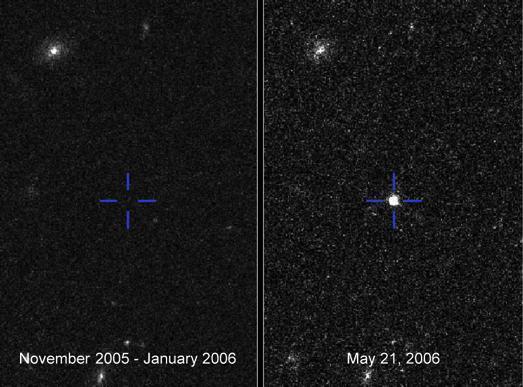An explosion of carbon-rich stars
While people are still fighting to remove unwanted cabins, it seems that the sky performs this task better. A new study has been discovered by astrophysicists at the University of Warwick that a mysterious stellar explosion recorded in 2006 could mark the abnormal demise of a star with more carbon. normal.
A strange object called SCP 06F6 was first noticed in 2006 by meteorologists in the US that captured images with the Hubble space telescope, which had never been seen anywhere. and fading after 120 days. The US group published their observations in September 2008, but did not find the nature of SCP 06F6, especially if it appeared in the backyard universe, or at an endpoint. another of the universe.
Now a group of meteorologists from Warwich University in England believe they are about to find the answer, according to their research, observations of SCP 06F6 bring remarkable similarities to one. a group of stars that contain a large proportion of carbon are called carbon-rich stars. However, to achieve a better fit, SCP 06F6 must be at a distance of about 2 million light years, creating a red light trail around their surface. From a predetermined distance, the sudden occurrence of SCP 06F6 is very likely related to the abnormal disappearance of a carbon-rich star, and the Warwick group believes that the object may be a new form of that. New system of supernovae.

SCP06F6.A new study has been discovered by astrophysicists at the University of Warwick that a mysterious stellar explosion recorded in 2006 could hide the abnormal demise of a star with more carbon. normal.( Photo: NASA, ESA, and K. Barbary / University of California, Berkeley)
This may be an unusual form of supernovae in many respects: SCP 06F6 is located in a void of the sky but not in any defined galaxy. If the star has exploded as a second normal form of supernova, why does it take up to 4 times the time to shine and fade out compared to this supernova? And why is it 100 times more luminous than X-ray energy compared to estimates? X-ray energy could make someone speculate that the star was destroyed by a black hole and not by itself, but the leader of Warwick University's team, Boris Gänsicke, said the idea was not There are no problems such as: 'the lack of a clear host galaxy for SCP 06F6 has shown that the ability to relate to black holes is very low (if black holes exist in the center of the galaxies often small) or black holes may be eliminated from the host galaxy. While no possibility is impossible, suppose a black hole has been invoked. '
'Some new telescopes that are currently being designed and built will continuously monitor the rest of the sky in search of a brief appearance of new stars, no doubt, SCP 06F6 will continue to make astronomers headaches in the coming years. '
References:
Boris Gaensicke, Andrew Levan, Thomas Marsh, and Dr Peter Wheatley. SCP06F6: A carbon-rich extragalactic transient at redshift z ~ 0.14? Astrophysical Journal Letters, June 1, 2009
- Stars change color when swallowing the planet
- The thousand-star explosion shot gold, silver and platinum throughout the universe
- Fossil-filled fossil soil was found
- The explosion of cosmic light was struck by two young stars
- The new discovery of cosmic explosion creates gold and platinum
- Sea carbon: Hypothesis is rich in iron
- Light from the first stars
- B3 - vitamins from space
- The formation of young star generations
- Decoding the origin of phenomena
- 9 interesting things about stars
- How is the super rich world kept by high technology?
 Van Allen's belt and evidence that the Apollo 11 mission to the Moon was myth
Van Allen's belt and evidence that the Apollo 11 mission to the Moon was myth The levels of civilization in the universe (Kardashev scale)
The levels of civilization in the universe (Kardashev scale) Today Mars, the sun and the Earth are aligned
Today Mars, the sun and the Earth are aligned The Amazon owner announced a secret plan to build a space base for thousands of people
The Amazon owner announced a secret plan to build a space base for thousands of people